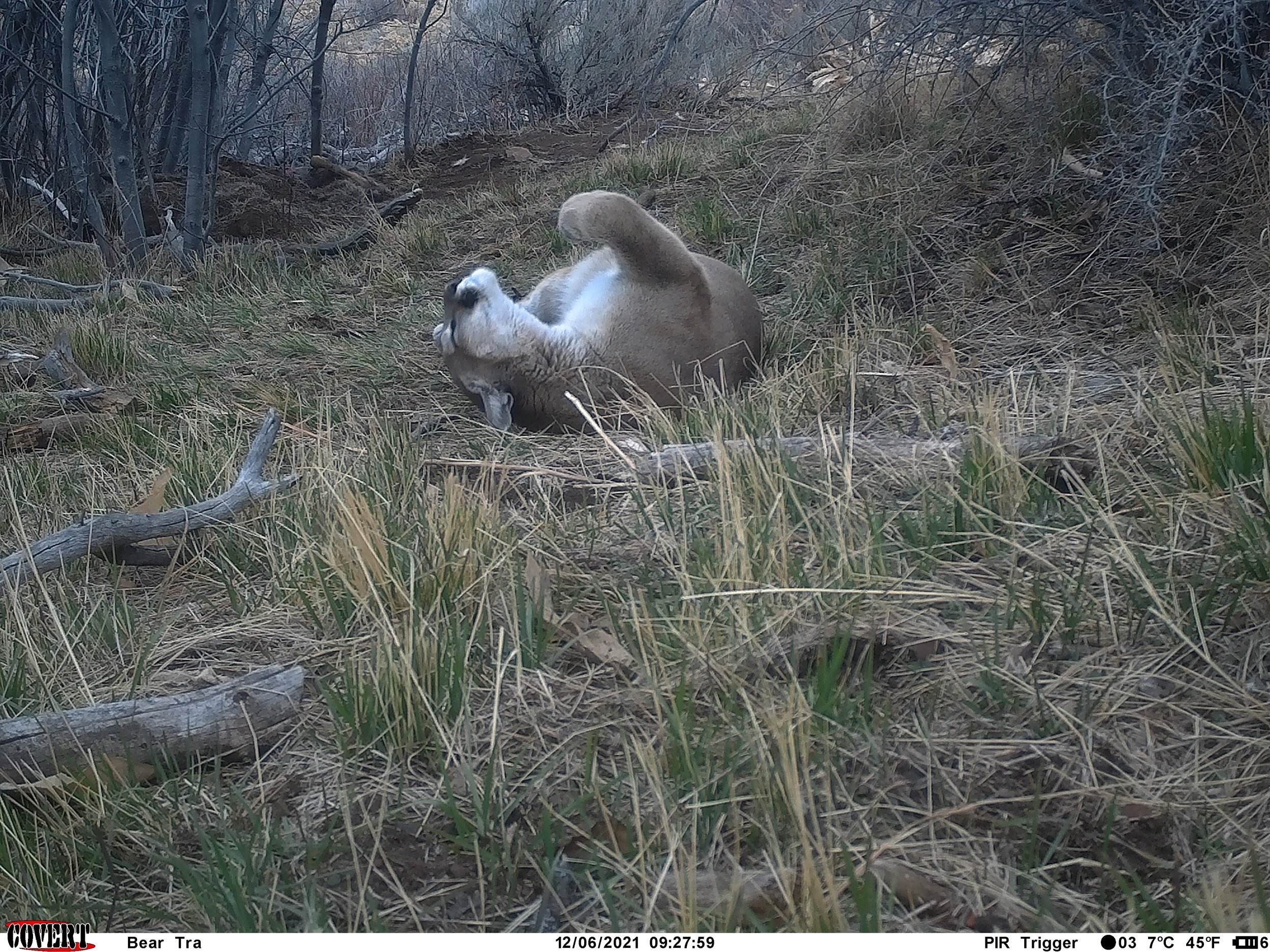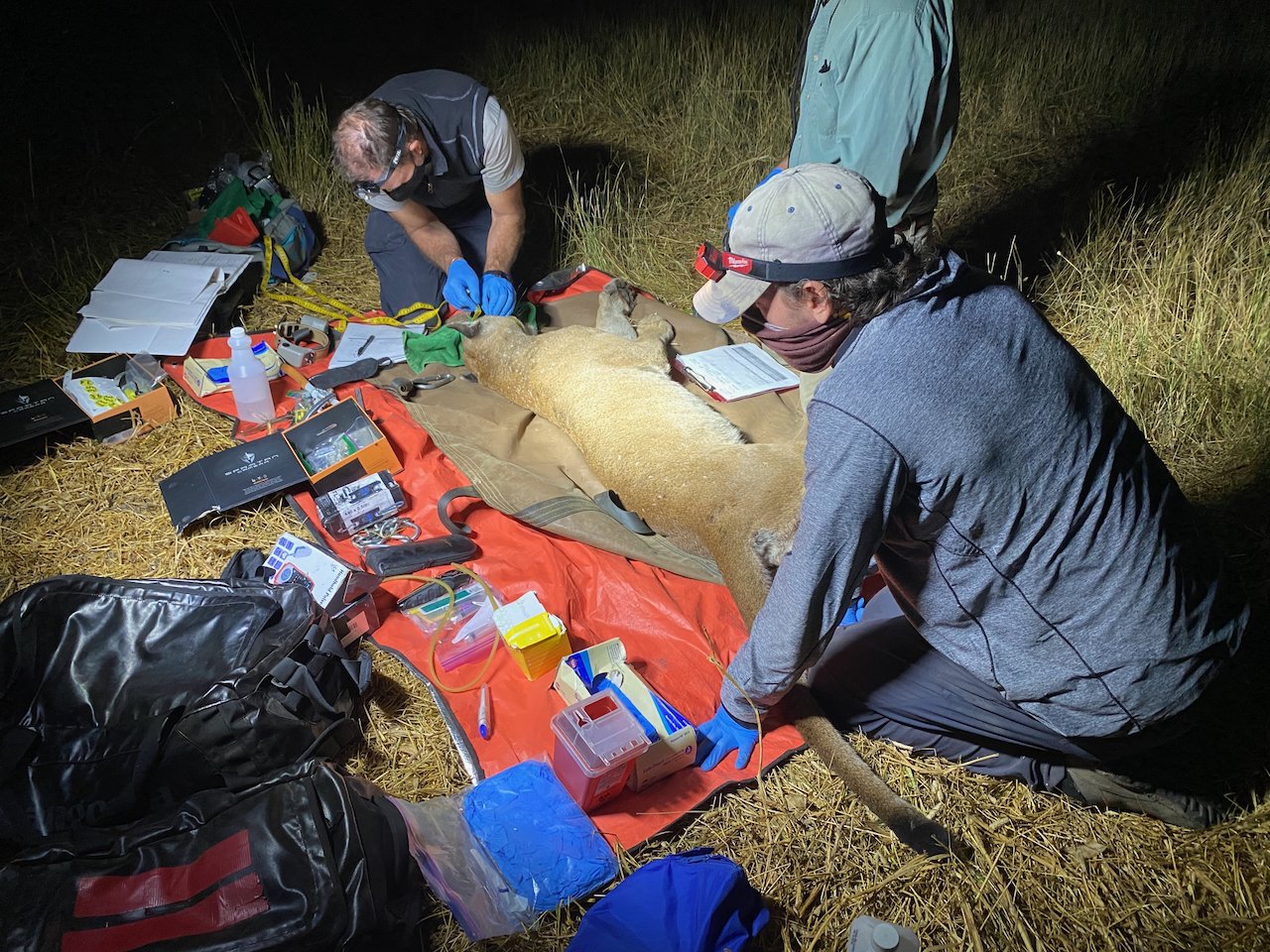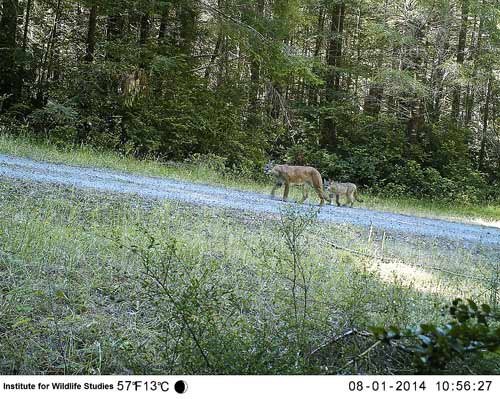Mountain Lion
Puma concolor
Sections:
Northeastern California Study*
North San Francisco Bay Study*
Whiting Ranch Regional Park Study*
Redwood National Park Study**
San Diego County Study
*ongoing project
**project completed
Mountain Lions in
Northeastern California
Since 2015 we have been examining the movements and food habits of mountain lions in northeastern California. As part of our ongoing study of the ecology of pronghorn in that region, we discovered that a high percentage of adult pronghorn mortality was caused by mountain lion predation. Because pronghorn usually occupy open sagebrush steppe habitat, biologists were surprised to learn that an ambush hunter like mountain lions could successfully prey upon pronghorn.
A juvenile male mountain lion feeds on the carcass of a deer that had been killed by his mother. He had already “left home” a few months earlier and his mother had a new litter of kittens. While still her offspring, she takes this opportunity to “explain” that her food is no longer his food.
It is thought that the changing vegetation structure on the Modoc Plateau (Modoc and Lassen Counties) may be contributing to the increased ability of mountain lions to prey upon pronghorn. Woodland habitat, made up primarily by encroaching juniper forest, has decreased the more open habitat historically characteristic of the plateau, and perhaps provided greater opportunities for mountain lions to get close enough to pronghorn to make successful attacks.
Taking a quick cat nap on camera. See more photos in slideshow below.
Further, mountain lions have never been studied in the northeastern part of the state and little is known of their habits in that region. As part of this investigation, we are trapping lions and placing GPS satellite collars on them to get detailed data on their movements. We will use these data to locate sites where they are likely to have made kills of prey species, and then we will investigate these kill sites to determine the species, sex and age of the prey species. We will also use locations of the sites to examine how mountain lions may be using the interface between the encroaching juniper woodland and the sagebrush habitat.
This investigation is being done in cooperation with the UC Davis Wildlife Health Center and the California Department of Fish and Wildlife.
Mountain Lions in
North San Francisco Bay
North of San Francisco lies an area encompassing Sonoma, Napa, and Mendocino counties that are collectively referred to as being part of the “North Bay”. A project to examine how mountain lions were using this populated area and how to help inform the public about lion ecology and behavior was given the moniker “Living with Lions”. The project was initiated by the Audubon Canyon Ranch, a local non-profit conservation and education organization. Dr. Quinton Martins of True Wild, LLC founded and leads the program, engaging in the capturing and collaring of mountain lions in the region and conducting community outreach regarding mountain lion biology and behavior.
IWS joined the project as a collaborator and is providing field staff and assisting with helping to develop project goals. It is truly exciting to be working with mountain lions in an area that contrasts rather significantly with our long-term lion project in the remote areas of northeastern California. In the North Bay, mountain lions live in close proximity with humans and there may be as many as 17,000 privately owned land parcels within the home range of a male lion. This overlap can lead to instances of livestock depredation (primarily goats used for brush control), therefore the project seeks to provide landowners with approaches to reduce the probability of mountain lions taking livestock, while concurrently providing insights into the role of lions on the landscape.
Tracking male P5 in Central Valley, CA
Mountain Lions in
Whiting Ranch Regional Park
Mountain lion walking a trail on Whiting Ranch.
Mountain lions can successfully reside close to human occupied areas, oftentimes without people even being aware that they are present. And, while extremely rare, mountain lion attacks on humans have occurred and this can make us uncomfortable when we learn that we are sharing the same general space with one of these predators. Understanding mountain lion behavior in and around areas frequently used by humans can enable managers to better inform recreational hikers and bikers regarding when and where they should demonstrate more caution. It can also help us see how mountain lions can co-exist near humans while fulfilling their ecological niche.
Mountain lion taking a drink from fountain on Whiting Ranch.
IWS is collaborating on a mountain lion study at Whiting Ranch Wilderness Park in Orange County, California by providing field staff and assisting with project design. The project is led by Dr. Winston Vickers of the University of California at Davis Wildlife Heath Center and is funded by Orange County Parks and the Natural Communities Coalition of Orange County. The goals of the study include helping to inform the County about where and when mountain lions are using the park, determining how the lion population use of the park varies by time of the year, and providing recommendations on how the park might best inform the public about lion activity on their property.
Mountain Lion Study in
Redwood National and State Parks
(previous project)
Mountain lion populations have been increasing in California since 1990 when the species was given state-wide protection from hunting. While mountain lion abundance has been increasing, little is known about what habitats mountain lions are using in northern California, particularly areas frequented by humans. Although mountain lions tend to avoid humans, conflicts with humans, livestock, and pets have increased as mountain lion populations have grown. Factors including increasing human populations and loss and fragmentation of mountain lion habitat are likely contributing to increased mountain lion-human interactions. Greater odds of interactions may especially occur in recreational lands where humans frequently use prime mountain lion habitat. Determining mountain lion abundance and habitat use in areas with frequent human use in northern California is paramount to the conservation of this native California cat.
Mountain lions are an important carnivore within the ecological community of Redwood National and State Parks (RNSP) and are rarely seen by visitors because these cats are very cryptic. Most of RNSP characterizes prime mountain lion habitat, which is also visited by over 400,000 people annually. Currently, mountain lion abundance and use of managed trails in RNSP is unknown and this information is needed to understand how mountain lions are using the area as their populations expand.
Jared Duquette (IWS research ecologist) and Micaela Szykman Gunther (Humboldt State University) conducted this study to collect data using remote cameras to understand trends in mountain lion abundance and when and where mountain lions and humans overlap use in RNSP. Our goal is to provide the first estimate of mountain lion abundance in RNSP and provide RNSP staff with greater understanding of mountain lion seasonal use of the area. We hope this initial study will lead to future research to understand the population demographics of mountain lions using RNSP.
Species identified:
Mountain Lion (Puma concolor)
Black Bear (Ursus americanus)
Bobcat (Lynx rufus)
Raccoon (Procyon lotor)
Hikers, bikers, and horse riders (Homo sapien)
Mule Deer (Odocoileus hemionus)
Gray Squirrel (Sciurus griseus)
Elk (Cervus elaphus)
Coyote (Canis latrans)
10. Gray Fox (Urycyon cinereoargenteus)
Striped Skunk (Mephitis mephitis)
Sooty Grouse (Dendragapus fuliginosus)
California quail (Callipepla californica)
Pacific Fisher (Martes pennanti)
River Otter (Lontra canadensis)
Dusky-footed Woodrat (Neotoma fuscipes)
Varied Thrush (Ixoreus naevius)
Mountain Lion Study in
San Diego County
The Institute participated in research examining the relationship between mountain lions (pumas), bighorn sheep, deer, domestic animals, and people in eastern San Diego County in southern California. The project was focused on activity in Cuyamaca Rancho State Park, Anza Borrega State Park, and surrounding areas. It was a collaborative effort among California State Parks, the Wildlife Health Center at the University of California, Davis, the California Department of Fish and Game, IWS, and others. The study is overseen by Dr. Walter M. Boyce, Co-Director of the Wildlife Health Center at U.C. Davis.
The objectives of the study, initiated in 2001, include estimating puma population density, determining individual home ranges, assessing the animals’ health status, and identifying puma activity patterns in relation to people and prey. Dr. Winston Vickers, Staff Veterinarian for IWS (left in photo), assists in puma captures, conducts physical exams, and collects samples to assess the animals’ health and disease status. Dr. Vickers has also conducted a survey of residents living near the parks to gauge opinions about current mountain lion management strategies, and to determine the percentage of pet and livestock owners in the area who adequately protect their animals from mountain lion predation.
Although puma attacks on humans are very rare, the number of dangerous encounters has increased in recent years. Since 1890, there have been 15 documented attacks on humans in California; twelve of those attacks, resulting in three deaths, occurred during the last 18 years. Two of those attacks, one fatal and one non-fatal, occurred within Cuyamaca Rancho State Park itself. Public safety concerns for park visitors were among the factors precipitating the puma project.
Since fieldwork began in 2001, we have studied 20 pumas, including 16 captured and collared in or near the parks. In accordance with the study objectives, capture and tracking data have been continuously collected and analyzed. Study results relating to puma behavior patterns indicate that pumas and people generally have opposite activity periods. Although pumas are least active during daylight hours when park visitors are most active, overlapping activity periods do occur around dusk and dawn. Pumas using the parks also tend to avoid buildings and campgrounds but move closer to the extensive system of trails and fire roads as night falls. With rising numbers of annual visitors to area parks for recreation, park managers continue to be concerned about increased opportunities for dangerous human-puma encounters.
Project researchers will continue to study the puma population in and around both parks. Because Cuyamaca Rancho State Park was extensively burned in the October 2003 Cedar Fire, new data are expected to provide unique information regarding post-fire puma behavior. Project findings will be used by park personnel to educate people about appropriate behavior in puma habitat, and steps that pet and livestock owners in the area can take to protect their animals. Additionally, considering the changes in vegetative cover caused by the fire, park managers may find the study results beneficial in managing trail and campground use by visitors











































